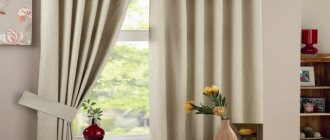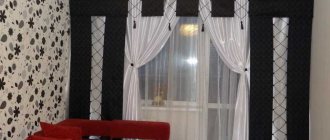The design of a personal room changes as the child grows older, and curtains in a nursery are a significant and expressive detail of interior design. They have a functional, practical purpose and create a special atmosphere in the room. What rules to follow when choosing curtains - today our material is about this.
Starry sky Source postelka.com.ua
Pirate-style curtain up to the window sill Source prom.ua
Types of curtains and their light transmission.
The purpose of curtains is to darken completely or partially the room from too bright sun, as well as artificial lighting. The ability of curtains to transmit sunlight may vary:
- blackout curtains – almost 100% prevent the ingress of sunlight;
- dimout curtains - do not darken the light completely (up to 80%); The fabric gently diffuses daylight creating twilight in the room, while artificial absorbs 90%.
In a children's room, it is very important to be able to adjust the brightness of the light, and for this it is best to choose a dense, light-proof material. This will help your baby fall asleep better.
In the evening, such curtains perfectly block artificial light, and during the day they prevent the penetration of daylight, allowing you to create night.
Light-proof curtains are not only dark. The material can be of various colors and shades, coffee, sand, light gray.
The transmittance of light is affected by the structure of the fabric, not its color.
Choose materials for curtains to suit your taste. Each material has its advantages and disadvantages:
- Cotton and linen. High-quality hypoallergenic fabric. You can choose any color you like. The disadvantage of this fabric is that it requires careful care and wrinkles quickly.
- Mixed fabric (cotton + elastane). Great combination. Easy to care for, they do not require additional cleaning. They are durable and do not fade in the sun.
- Organza. Lightweight synthetic material. It dries instantly and does not wrinkle, but is practically unable to protect from the sun. Organza is usually complemented with curtains.
It is not advisable to add silk curtains to a child's room. This is a very fragile material that quickly develops snags.
Silk curtains will quickly deteriorate and become unusable. You should also not choose heavy fabrics such as velvet or corduroy. Such fabrics can collect large amounts of dust, which can contribute to allergic reactions in a child.
Choosing curtains depending on the gender of the child
It has become traditional that girls choose delicate tones (shades of pink, purple, lilac), while boys often choose shades of blue and green. Accordingly, the thematic design is different. But don't rush to make a choice.
Take a closer look at your child to see what colors he most often uses when drawing. It is this color scheme that is closer to him and determines his character trait. The established tradition only generalizes the observations of psychologists. Everyone has their own favorite color, not just children.
How to decorate curtains for girls:
- traditional techniques - ruffles, frills;
- decorative braid;
- bows and voluminous flowers made by hand from tulle fabric;
- magnets with butterflies and dragonflies;
- You can sew beads and colored buttons on top of the fabric;
- make a rigid lambrequin based on adhesive fabric and non-woven fabric;
- Instead of tulle, use thread curtains with beads.
For boys:
- Marine theme. As a complement to the curtains, take a mesh curtain fabric. Make and hang a rigid lambrequin in the shape of a ship.
- Football theme. Curtain-mesh and balls curved on a rigid frame made of adhesive dense fabric.
- Space theme. Rigid rocket lambrequin and blue curtains with cut out stars. The edges of the stars are cauterized or glued.
Your child will take an active part in creating the ensemble; joint creativity will make it possible to turn the window decor into a small masterpiece.
Shape and length
Elegant curtains will be an ideal addition to the design of a nursery. In addition to material and color, the shape of the product plays an important role. Their durability depends on it.
Curtains + tulle are an excellent solution for a nursery. The tulle can be brighter, and the curtains can be a calm light shade. Voluminous tulle will look great in a girl’s children’s room, and straight tulle in a gray-blue shade will look great in a boy’s room.
Combined curtains are an excellent choice for a children's room. These can be products from different textured materials, two-color curtains - opposite or similar shades.
There are the following finishing methods with combined curtains: contrasting and harmonious. In the first option, two opposite shades are made, in the second, two colors that are similar in tone.
It is better to choose a harmonious option for the children's room and add bright details. Short curtains are the most ideal and practical solution for a children's room.
There are several types of short curtains that will fit perfectly into the interior of a nursery: these are French, Austrian and Roman curtains.
- French are fabrics draped with a large number of folds, which are located throughout the product and remain so, both in the raised and lowered position. Along the bottom of the product, cords pass through loops, which form scallops when pulled together.
- Austrian curtain is a fabric with a sewn-in curtain tape and a length-regulating mechanism. They are usually sewn from too dense materials - velvet, damask. Currently, lightweight materials such as silk and taffeta are already used for sewing curtains. You can beautifully combine them with headbands and bows.
- Roman blinds for children's rooms of the classical type are most often chosen. After lifting, they form perfectly even folds. When the classic design is lowered, it covers the entire window completely, and the canvas itself looks smooth. The drawstrings for the classic design are soft, which ensures the formation of smooth folds. Made from cotton, linen and polyester. A practical solution for small rooms.
Calico curtains for children's rooms
Calico is an excellent choice for parents. Affordable, high quality, resistant to shrinkage after washing.
The structure of the material is quite dense, but the fabric does not disrupt the natural circulation of air in the room.
Note!
- Children's room for a schoolchild: 120 photos and video description of how to choose a stylish and functional design for the room
- Bed for a children's room - 165 photos and video description of how to choose the right bed
- Carpet for a children's room - 155 photos of options for insulating a child's room using carpets
Curtains for a child's room for a girl
The most popular option for little girls is delicate white and pink curtains with ruffles. Nevertheless, designers recommend decorating the children's room more individually.
You can choose any color, but it is better to choose calm, discreet shades. An excellent choice for a girl - lilac, delicate mint, warm yellow.
It is also worth paying attention to details for curtains in a girl’s room, such as:
- small peas or floral pattern
- stripes of different shades of the same color scheme
- air lambrequins
- tiebacks - bows.
It’s a great idea to complement the design of a girl’s room with other elements made of the same material, such as a curtain. There is no need to overload the room with too bright colors when decorating it. It is better to choose gentle, calm tones, and the interior can be slightly supplemented with bright details.
Choosing a color
When decorating a room for a baby, do not choose aggressive and bright shades. Give preference to a restrained, calm palette that will create a feeling of security, reliability and warmth. Choose a light blue color scheme; gold, honey and sunny shades are also suitable. For small children, ornamentation is not yet important, so it is better to choose plain textiles.
Not only monochrome fabrics are suitable for older children. You can add prints to the room by diluting the neutral palette with bright shades - for example, blue, green or even red. The optimal age for such changes is 3 years.
Tip: if you need to encourage your child to be active, choose a red color for the curtains. However, red in its pure form can be psychologically irritating and cause a feeling of anxiety, so it is better to soften this effect by choosing muted shades in this range. Derivatives from the red tone - pink and purple - are perfect.
When creating an interior for schoolchildren, you need to take their wishes into account. Sometimes these can be the most daring and contrasting combinations, for example, white and black, or green and yellow. Some teenagers like denim curtains or street art patterns. At this age, the manifestation of individuality is fundamental and important even in the choice of curtains.
It is worth remembering that curtains that are too bright quickly become boring; children often do not understand this. In this case, curtains with a stylized pattern will be a compromise; besides, abstraction perfectly develops the creative and thinking process in children.
The other extreme is a classic design with floral patterns. You may like this option, but this design is not interesting for children.
Curtains for a boy's room
Curtains in a boy's room should be comfortable and unusual.
Typically, boys like sea colors - bright blue, soft blue, and ultramarine shades. It must be kept in mind that all design elements must be in harmony with each other. If you want to make a children's room in a sports style, then there should be no other theme.
But, before you decorate a children's room, choose curtains or other decor, you need to find out what your little one likes and is interested in. For example, if he likes the cartoon “The Fixies,” then curtains with his favorite cartoon character will only make him happy.
Classic designs for curtains in a boy’s room – racing cars, birds, animals, giraffes. These can also be photo curtains with images of animals or cartoon characters.
But you need to keep in mind that you need to do it in such a way that your baby likes it. If the boy does not have any specific preferences, then the best option is curtains without a pattern in his favorite color.
What you need to pay attention to when choosing curtains
Before choosing curtains, you need to consider several factors, the most important of which are the environmental friendliness and hypoallergenic nature of the material. It is also good if they are simple and easy to care for, because it is known that children's curtains will be washed very often.
It is important to take into account the age and gender of the child. After all, small children are very active and strive to pull something or throw something off. Therefore, special attention should be paid to the issue of safety. For example, when playing hide and seek, children very often use curtains as an object to hide behind, which certainly guarantees dirty prints on the surface.
Based on the practical side of the issue, we can conclude that the use of expensive and exclusive materials to decorate a children's room is not entirely appropriate, and curtains can always be replaced when children reach a later age.
Try to choose the material for curtains in such a way that it best suits the interior of the children's room.
You should not opt for dense and heavy fabrics; it is better to opt for light and airy curtains
Modern printing houses will be able to transfer beautiful drawings onto paper from almost any object - in this case, these are funny children's paintings
To keep children as safe as possible, use high-quality fastenings for curtains and curtain rods<.>
</.>
Curtains for a teenager's room
It is better to choose curtains for a teenager together with him. You need to show your teenager that his choice is very valuable to you. Usually, during adolescence, children try to abandon unnecessary childishness in the interior, choosing stylish minimalism.
You can offer your teenager the following options:
- Roman curtains. They cover the window well and block light well. An alternative option is roller blinds. The only difference is in the assembly mechanism. You can choose fabric of the same color without a pattern or with abstraction.
- Curtains without any patterns, ornaments or lambrequins. For a teenage girl, cream or just snow-white ones are more suitable. A teenage boy can choose light brown, graphite, and dark blue options.
- Photo prints. Teenagers may also like curtains with views of nature, sea surf, and a beautiful city. A great option is your own photo or an image of your idol.
Decorating a children's room in a small apartment is a pressing and difficult task. There is very little space in apartments of this type, so you need to take into account the footage.
Such a room does not need to be furnished with a lot of furniture. To visually make the room larger, you need to choose pastel colors for covering the walls and ceiling, as well as material for furniture and curtains. You should not create a design in dark colors.
When choosing curtains for a child's room, it is important to remember that they should be combined in style with other interior items such as colored wall coverings, flooring and furniture. It is important to do everything efficiently, practically and harmoniously.
Sewing curtains with your own hands
Since there are a huge number of options, it is better not to choose something too complex for the first time. The easiest way is to sew even curtains for the nursery, and then drape them on the cornice. These options can be assembled from above or below and they will look good. Instructions for self-production:
- To get started, buy fabric with enough reserve for drapery. At the same time, you do not need to drape too much; a large number of folds will collect dust and make the window opening heavier.
- The easiest way to measure a piece of the desired size is on the floor, which is previously cleared. Small curtains for a nursery can be measured and cut on the table. Use sharp, large enough scissors for cutting. The main thing is to draw a line in advance using a long ruler or any available object.
- Before starting work, be sure to steam the curtains, this will simplify further work. It is very important to determine the direction of the pile in the fabric so that it is positioned equally in the curtains, otherwise the shade may differ due to the fact that the light will pass differently. If you have material with a pattern, then you need to choose it so that the curtains are symmetrical.
- At the bottom, leave an allowance of 10 to 15 centimeters for the hem; at the top you need a margin of a few centimeters to sew on the braid for the cornice. As for the sides, you don’t need to leave much – two centimeters is enough.
- After a piece of the desired size is cut, it is best to overlock the edges so that they do not fray. Make a hem at the bottom, and sew a braid with eyelets on top, after which you can hang the finished curtains on the cornice and enjoy the result.
If you decide to sew a more complicated version, then you need to organize the work differently. First of all, you need to find patterns. You can find many interesting solutions, choose what you like and download ready-made patterns.
First you need to make a life-size template; for this you can use wrapping paper or pieces of wallpaper remaining after the repair. Make the elements with the exact configuration, then lay them out on the straightened fabric and secure with pins.
Important! If you have little experience in sewing and cutting, then do not choose too complex models.
Photos of curtains for a children's room
Share with friends:











